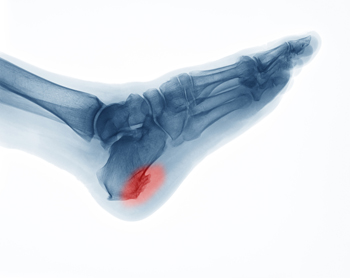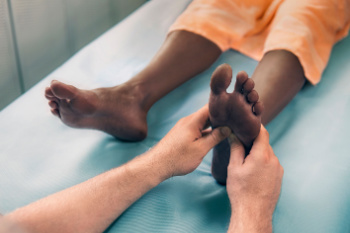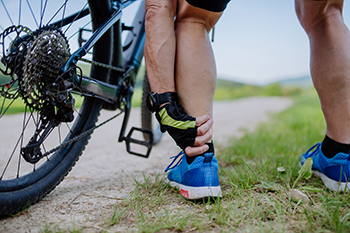Connect With Us
Blog
Items filtered by date: May 2024
When Surgery Is Needed for Heel Spurs

When conservative treatments prove ineffective in easing the discomfort, inflammation, and swelling associated with heel spurs, surgery emerges as a viable solution. These outgrowths on the heel bone, medically termed calcaneal spurs, can cause significant pain and impede mobility. The decision to pursue surgery hinges not solely on the size or presence of the spur, but rather on the persistence of pain resistant to treatment. Podiatrists typically advocate for surgery when symptoms persist despite six months of non-surgical interventions. Two primary approaches exist for heel spur surgery, which are known as open surgery and endoscopic surgery. Open surgery entails larger incisions and is generally employed to excise entire spurs. Endoscopic surgery employs smaller incisions, fostering quicker recovery and fewer complications. The surgical procedure may vary depending on the spur's location, whether it is inferior or posterior. Inferior heel spurs often coexist with plantar fasciitis and are addressed through plantar fasciotomy. Posterior heel spurs near the Achilles tendon may necessitate more intricate procedures, especially if the spur is deeply embedded within the Achilles tendon. While heel spur surgery has a high success rate, it also carries risks of nerve injury, foot instability, and acquired flat feet. If you are in pain from a heel spur, it is suggested that you consult a podiatrist who can determine what the best course of treatment is for you.
Heel spurs can be incredibly painful and sometimes may make you unable to participate in physical activities. To get medical care for your heel spurs, contact Stephanie Oexeman, DPM from Oexeman Foot and Ankle, PLLC. our doctor will do everything possible to treat your condition.
Heels Spurs
Heel spurs are formed by calcium deposits on the back of the foot where the heel is. This can also be caused by small fragments of bone breaking off one section of the foot, attaching onto the back of the foot. Heel spurs can also be bone growth on the back of the foot and may grow in the direction of the arch of the foot.
Older individuals usually suffer from heel spurs and pain sometimes intensifies with age. One of the main condition's spurs are related to is plantar fasciitis.
Pain
The pain associated with spurs is often because of weight placed on the feet. When someone is walking, their entire weight is concentrated on the feet. Bone spurs then have the tendency to affect other bones and tissues around the foot. As the pain continues, the feet will become tender and sensitive over time.
Treatments
There are many ways to treat heel spurs. If one is suffering from heel spurs in conjunction with pain, there are several methods for healing. Medication, surgery, and herbal care are some options.
If you have any questions feel free to contact our office located in Chicago, IL . We offer the latest in diagnostic and treatment technology to meet your needs.
How Various Forms of Arthritis Can Affect Feet

Arthritis, a condition causing joint inflammation, manifests in various forms, each impacting the feet differently. Osteoarthritis, the most common type, affects the cartilage, leading to joint pain and stiffness. In feet, it often targets the big toe, making it painful to walk or stand. Rheumatoid arthritis, an autoimmune disease, affects joints symmetrically, often leading to deformities in the feet such as bunions and hammertoes. Gout, characterized by sudden, severe attacks of pain, swelling, and redness, typically targets the big toe joint. Psoriatic arthritis, linked with psoriasis, can cause swelling in the toes. Ankylosing spondylitis, affecting the spine and large joints, may also cause inflammation in the feet, leading to stiffness and discomfort. If you have any arthritic foot pain, it is suggested that you make an appointment with a podiatrist who can offer a personalized treatment to help alleviate discomfort and improve mobility.
Arthritis can be a difficult condition to live with. If you are seeking treatment, contact Stephanie Oexeman, DPM from Oexeman Foot and Ankle, PLLC. our doctor can provide the care you need to keep you pain-free and on your feet.
Arthritic Foot Care
Arthritis is a joint disorder that involves the inflammation of different joints in your body, such as those in your feet. Arthritis is often caused by a degenerative joint disease and causes mild to severe pain in all affected areas. In addition to this, swelling and stiffness in the affected joints can also be a common symptom of arthritis.
In many cases, wearing ill-fitting shoes can worsen the effects and pain of arthritis. Wearing shoes that have a lower heel and extra room can help your feet feel more comfortable. In cases of rheumatoid arthritis, the arch in your foot may become problematic. Buying shoes with proper arch support that contour to your feet can help immensely.
Alleviating Arthritic Pain
- Exercises that stretch the foot can prevent further pain and injury and increase mobility
- Most of the pain can be alleviated with anti-inflammatory drugs, heat, and topical medications
- Massages can help temporarily alleviate pain.
It is best to see your doctor for the treatment that is right for your needs and symptoms. Conditions vary, and a podiatrist can help you determine the right method of care for your feet.
If you have any questions, please feel free to contact our office located in Chicago, IL . We offer the newest diagnostic tools and technology to treat your foot and ankle needs.
Let the Expert Treat Your Ingrown Toenails
Stretches for Plantar Fasciitis

If you have ever experienced the sharp, stabbing pain of plantar fasciitis, you know how debilitating it can be. Plantar fasciitis, caused by inflammation of the ligament running from the toes to the heel, often results from overuse. However, relief may be closer than you think and involves simple exercises. Begin by sitting with feet flat on the floor, lifting the leg with the sore foot, and placing that ankle on the opposite leg. Flex your toes toward your shin, feeling the stretch under your foot for five seconds, and repeat 10 times. Then, sit with your feet flat and place a frozen water bottle on the floor, rolling it under your foot for one to two minutes, focusing on painful areas. Similarly, use a golf or tennis ball to massage the sole of your foot, targeting painful areas. These simple stretches can provide immense relief, but for a more comprehensive treatment plan tailored to your specific needs, a podiatrist can help. This foot and ankle specialist can offer personalized advice and other methods to address plantar fasciitis effectively. For relief from plantar fasciitis pain, it is suggested that you consult a podiatrist today.
Plantar fasciitis can be very painful and inconvenient. If you are experiencing heel pain or symptoms of plantar fasciitis, contact Stephanie Oexeman, DPM from Oexeman Foot and Ankle, PLLC. our doctor can provide the care you need to keep you pain-free and on your feet.
What Is Plantar Fasciitis?
Plantar fasciitis is the inflammation of the thick band of tissue that runs along the bottom of your foot, known as the plantar fascia, and causes mild to severe heel pain.
What Causes Plantar Fasciitis?
- Excessive running
- Non-supportive shoes
- Overpronation
- Repeated stretching and tearing of the plantar fascia
How Can It Be Treated?
- Conservative measures – anti-inflammatories, ice packs, stretching exercises, physical therapy, orthotic devices
- Shockwave therapy – sound waves are sent to the affected area to facilitate healing and are usually used for chronic cases of plantar fasciitis
- Surgery – usually only used as a last resort when all else fails. The plantar fascia can be surgically detached from the heel
While very treatable, plantar fasciitis is definitely not something that should be ignored. Especially in severe cases, speaking to your doctor right away is highly recommended to avoid complications and severe heel pain. Your podiatrist can work with you to provide the appropriate treatment options tailored to your condition.
If you have any questions please feel free to contact our office located in Chicago, IL . We offer the newest diagnostic and treatment technologies for all your foot and ankle needs.
Foot and Ankle Injuries During Multi-Day Bicycling

Embarking on multi-day bicycling adventures can be exhilarating, but it is essential to be mindful of potential foot and ankle injuries that may arise during prolonged rides. One common issue cyclists encounter is overuse injuries, such as Achilles tendonitis or plantar fasciitis, caused by repetitive pedaling motions. These conditions can lead to pain, stiffness, and inflammation in the foot and ankle, impacting performance and enjoyment. Additionally, improper bike fit or footwear can contribute to discomfort and strain on the feet and ankles, increasing the risk of injury. Furthermore, cyclists may experience acute injuries from falls or collisions, such as ankle sprains or fractures, which require immediate attention and care. To prevent foot and ankle injuries while cycling for multiple days, cyclists should ensure wearing supportive footwear, incorporate rest breaks and stretches into their rides, and listen to their bodies for signs of discomfort or fatigue. If you have endured a foot or ankle injury while bicycling, it is suggested that you consult a podiatrist who can provide you with an accurate diagnosis and treatment options, in addition to tips that can help to prevent future cycling injuries.
Ankle and foot injuries are common among athletes and in many sports. They can be caused by several problems and may be potentially serious. If you are feeling pain or think you were injured in a sporting event or when exercising, consult with Stephanie Oexeman, DPM from Oexeman Foot and Ankle, PLLC. our doctor will assess your condition and provide you with quality foot and ankle treatment.
Common Injuries
The most common injuries that occur in sporting activities include:
- Achilles Tendonitis
- Achilles Tendon Rupture
- Ankle Sprains
- Broken Foot
- Plantar Fasciitis
- Stress Fractures
- Turf Toe
Symptoms
Symptoms vary depending upon the injury and in some cases, there may be no symptoms at all. However, in most cases, some form of symptom is experienced. Pain, aching, burning, bruising, tenderness, tightness or stiffness, sensation loss, difficulty moving, and swelling are the most common symptoms.
Treatment
Just as symptoms vary depending upon the injury, so do treatment options. A common treatment method is known as the RICE method. This method involves rest, applying ice, compression and elevating the afflicted foot or ankle. If the injury appears to be more serious, surgery might be required, such as arthroscopic or reconstructive surgery. Lastly, rehabilitation or therapy might be needed to gain full functionality in the afflicted area. Any discomfort experienced by an athlete must be evaluated by a licensed, reputable medical professional.
If you have any questions, please feel free to contact our office located in Chicago, IL . We offer the newest diagnostic and treatment technologies for all your foot care needs.

